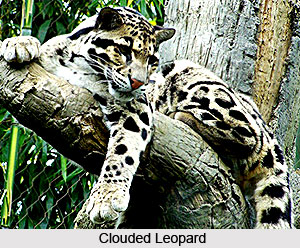 The Indian Clouded Leopard belongs to the Neofelis genus and has the scientific name is Neofelis nebulosa. The average lifespan of the clouded leopard is nearly eleven years and if they are confined they live for seventeen years.
The Indian Clouded Leopard belongs to the Neofelis genus and has the scientific name is Neofelis nebulosa. The average lifespan of the clouded leopard is nearly eleven years and if they are confined they live for seventeen years.
The Indian Clouded Leopard grows for nearly sixty to one hundred and ten centimeters. The Indian leopards have a tan colour skin and has large complex shaped dark-edged ellipses marks on its body. The ellipses are shaped like clouds and hence they are named `clouded Leopards`. They have a robust body and their canine teeth are the longest among all the cat species. The short and flexible legs, the large paws and the sharp claws of the Clouded Leopard are ideal for climbing trees. The tail of this animal is as long as its body and is an advantage for climbing. The cubs of the Clouded Leopard do not have dark ellipse and have a darker skin tone.
The Indian Clouded Leopard is carnivorous which consumes terrestrial mammals, tree climbing animals, primarily consisting of gibbons, macaques and proboscis monkey. Its other prey includes small mammals, deer, birds, porcupines, and domestic livestock. Indian Clouded Leopards prefer to live in tropical and the subtropical forest regions of India at an average height of two thousand meters. They can also be found in the Indian mangrove swamps and grasslands. They are solitary creatures that prefer isolation and can rarely be seen in groups.
The female Clouded Leopard becomes mature at nearly two years of age. The gestation period lasts for eighty five to ninety three days and it gives birth to one to five cubs at a time. The cubs become active within five weeks of birth and become independent after ten months. The Indian Clouded Leopard has been marked as an Endangered species of Wild Fauna and Flora.



















